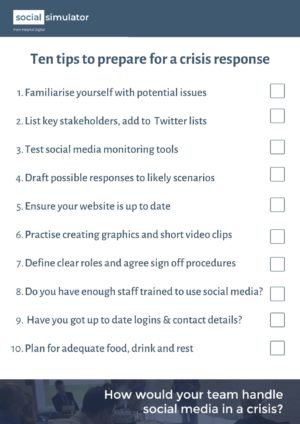National Preparedness Month takes place every September in the US. It’s an opportunity for emergency responders and government organisations to encourage their audiences to be prepared for any kind of emergency. There’s always plenty of useful tips shared. But if you are responsible for communicating such advice, how do you prepare yourself for a crisis?
We’ve put together some tips for communications teams, and also some insights into how we prepare for our crisis simulations. Our Social Simulator is designed to mock up an online crisis and allow teams to test their crisis response in a safe space. Much of the work we do to prepare has parallels to the work teams can do to prepare themselves.
Scenario planning
When we’re working with clients we spend a great deal of time looking at their organisation, the likely crises they might face, and then develop a realistic scenario to test their online communications via our closed platform. These might be emergencies, natural disasters, or reputational issues.
You can prepare for potential crises by:
Ensuring you know what issues your company or organisation could face – make sure you know who in your organisation is responsible for identifying potential risks and preparing for them and how you can work with them
Capturing details of your key stakeholders – this may vary for different types of crisis situation. Private Twitter lists are a good way to keep an eye on what they are saying day-to-day and during an incident
Research
We work with our clients on a realistic scenario that will test their crisis response plans. We look at who the key stakeholders would be, where audiences might spend their time on line and this influences the channels we set up in the platform. Sometimes it’s heavily dominated by our replica of Facebook, other times Twitter is key: we can also include Instagram, LinkedIn and Youtube and internal comms channels.
You can prepare to respond well in a crisis situation by:
Familiarising yourself with one or more social media monitoring tools and the information they provide. What is a normal level of conversation about your organisation and what is the usual sentiment?
Capturing a list of the main influencers in key areas of your organisation’s work
Being aware of any issues your partners or competitors have faced: how did they play out online, what questions were they asked, how well did they respond?
Content
To make our simulations as realistic as possible we prepare social media posts, online news articles and even video clips of news stories
You can prepare by:
Drafting possible responses to questions about your likely scenarios
Checking FAQ type information is up to date on your website. Could you quickly and easily point people to the information they are likely to need?
Making sure you are familiar with writing and uploading social media posts, creating graphics and taking and editing short video clips
Team members
Our team includes knowledgeable crisis communicators who have worked for large government departments and crisis communications agencies. During a simulation they role-play journalists, partners, the public and employees to ensure a realistic experience. We’ve now done over 100 exercises so they are well versed in testing teams and replicating crisis situations.
You can prepare by:
Having clear roles in your communications team and a plan for how you will get the information you need and the process for getting information signed off for publication
Being sure you can staff a rota for each role in an ongoing crisis, you may need to respond for days, weeks, or even months.
Checking you have up to date contact details for everyone who might need to be involved: crises don’t respect working hours, there’s a good chance things might escalate outside of your office hours.
Having a grab bag ready for a situation where you might need to relocate quickly to another office or work from home
Here’s an example of how to structure your response team. We find the best teams: define roles, set objectives, have clear strategies, know their tactics, and check in frequently. Find out more in this blog:
Final preparations
The kit we take varies but can include laptops for ourselves and participants, wifi provision, post-it notes, charging cables; we don’t travel light! We also check and double check login and password details, IT settings for where we are going to be delivering the exercise, and that everything is in place for a successful exercise.
You can prepare by:
Ensuring you know how to access your social media accounts and management tools from the office or remote locations.
Does everyone have the tools they need to work effectively in a crisis situation?
How does your organisation define a crisis – how will you know when to step things up?
If you need people to cover social media, have they had the opportunity to shadow regular team members and gain experience?
Thinking about food and drink. If you have an office restaurant – brilliant – but is it open 24/7? What are your options for keeping everyone from becoming hungry, thirsty and tired? What could you keep in the office for such situations, or where could you source food and drink from if needed? Looking after your team is a vital component of a good crisis response
You never know what might be about to happen but you can make sure you are ready to manage it. Prepare and practise to perform at your best in a crisis.
Download our checklist of simple preparation tips and see how ready you are to respond to a crisis.

